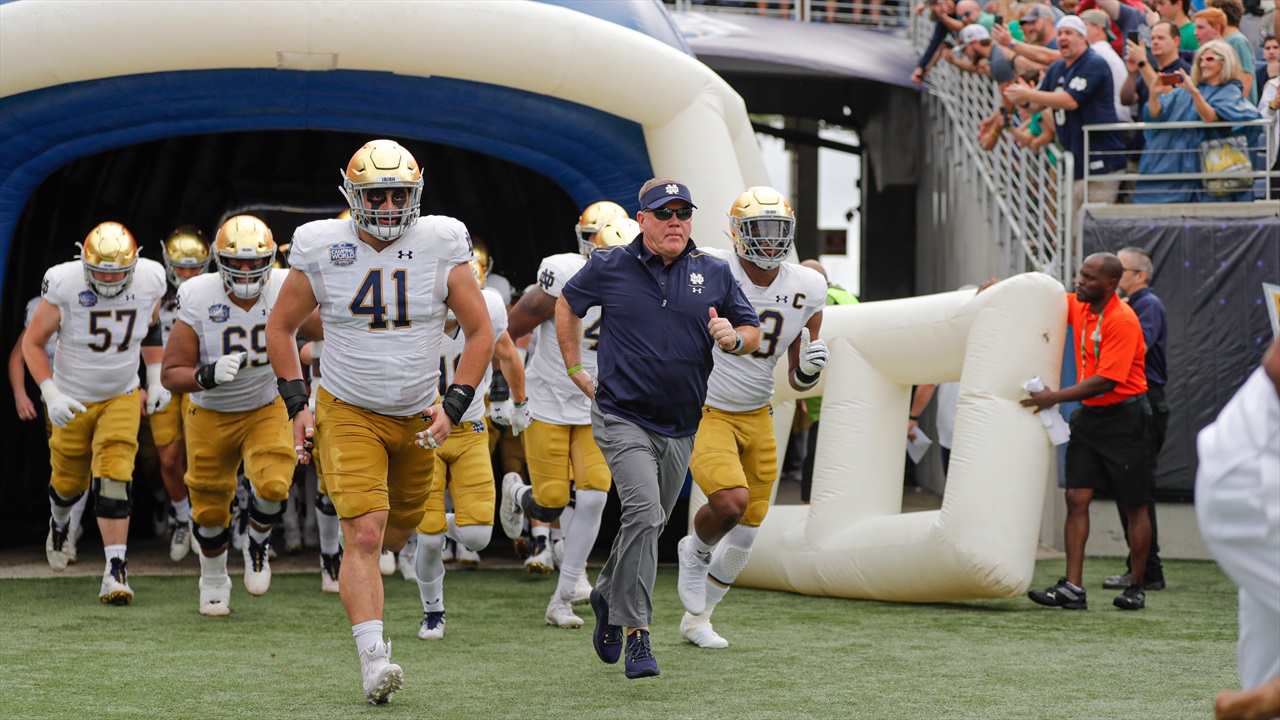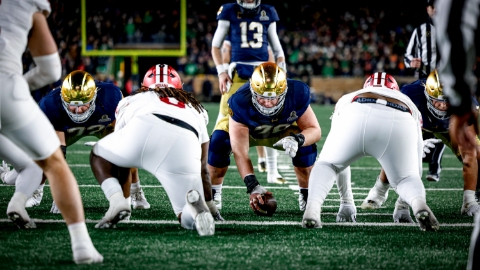Recruiting keeps going, staffs keep getting larger across college football

College athletics, same as its youth and professional sports brethren, ground to a halt in March.
The COVID-19 pandemic coerced a months-long void of athletics competition nationwide and only recently has shown signs of a modest, fan-free return to competition.
Long before NASCAR and the PGA Tour elected to resume their truncated seasons, college athletics had shown an old adage held true, even in an unprecedented modern health disaster: recruiting does not rest idle.
"Head down and really working hard on relationship building, albeit through written correspondence, text, Social Media, FaceTime, Zoom meetings,” Notre Dame coach Brian Kelly said earlier in the pandemic. “We're using all the platforms that are available to us. I think we're making great progress. We're able to dig deep on our distinctions and what separates us and we're utilizing our support staff and faculty to really tell our story as to what our unique distinctions are at Notre Dame.”
For college football, even without allowable NCAA visits and myriad de facto ghost towns passing as former bustling campus sites, the drumbeat marches onward. Virtual tours now are commonplace for nearly every college and university; their existence, but not their ubiquitousness, predates the COVID-19 shutdown.
Perhaps even more widespread, however, is the growth of recruiting departments, especially across the past decade in college football, and the recruiting methodologies used therein --- though many schools in this story asked for secrecy because, well, imitation is flattery and college football loves its copycats.
Top-20 consensus recruiting classes tend to spawn not just from winning programs, states with high concentrations of elite football talent, such as California, Florida, Georgia and Texas, but also from programs whose off-field football staffs oftentimes are among the largest in the nation.
The NCAA in 2018 enacted measures to allow a 10th full-time assistant coach for Football Bowls Subdivision programs; anything directly limiting the size of recruiting departments, or the help those staffs receive from the college game’s relatively new analyst position, is far more nebulous.
Notre Dame, for example, has five full-time recruiting staff members and a graphic designer for a six-person staff. The Fighting Irish also try to maintain one intern, and eight students who work part-time on a limited basis. In a normal season full of big official visit weekends, ND also enlists the help of 30 to 35 student-ambassadors to assist with hosting duties during the course of those visits.
Still, the Fighting Irish boast just five analysts and rely on a cohesive team-approach in recruiting that shows Notre Dame’s staff size lags behind those of some of its competitors --- both in the Atlantic Coast Conference and nationally.
One ACC school, whose coaches asked not to be identified, said they have four full-time employees dedicated to recruiting, plus the graphics director is full-time for recruiting, a recruiting graduate assistant and roughly 10 to 12 students “at almost all times.”
The system beyond that also is quite intricate. Per a football department staff member at the school, “Coaches have their own full-time guy assigned to them who trims film, evaluations and has a student to help with projects. The position coach and area coach work between the kids and parents.”
Then, from the head coach on down, the plan ensures that some member of the coaching staff is hitting the recruiting front every single day.
“Some coach on staff is touching their top guys every day,” he said. “They rotate that responsibility so that all coaches are getting to know the top targets."
At Alabama, the Crimson Tide list 13 football analysts, including a pair of former head coaches in Charlie Strong and Major Applewhite; it also has former Cincinnati and Tennessee head coach Butch Jones as a “special assistant” to Nick Saban. The Tide have 10 more football employees in player development, personnel and/or recruiting.
Defending College Football Playoff champion LSU lists 21 staff members as analysts, personnel and recruiting operations.
Ohio State employees approximately a dozen full-time members in roles of recruiting, player personnel and quality control coaches, many of whom also are involved in recruiting. Similarly, OSU taps into part-time student workers as well to assist in recruiting efforts. The Buckeyes currently have the top-ranked 2021 recruiting class, per multiple services, and count nine commitments during the pandemic.
One Big 12 school had five full-time employees dedicated to recruiting, plus a graphics leader, and another “eight to 10” students working part-time. However, one staff member departed earlier this spring and no replacement had been hired due to budget tightening during the pandemic.
Per a former Ole Miss staffer, the Rebels last year had five full-time employees in their recruiting department and “10 to 12 students working part-time.”
One PAC-12 school that spoke to Irish Sports Daily said that it was in the process of doubling its recruiting department at the onset of the pandemic, as it was set to move from five full-time members to a total of 10 with the planned additions of five new members for its football creative design department.
University of Memphis, a participant last year in the New Year’s Six with a Cotton Bowl berth opposite Penn State, has 17 members of its football staff in high school relations, personnel, recruiting and quality control positions.
Central Florida, a two-time New Year’s Six participant in recent years, has four full-time workers dedicated to the recruiting department, including the graphic designer, an operations student and four personnel volunteers.
At Tennessee, which presently has the nation’s No. 2 recruiting class across multiple rankings, Jeremy Pruitt is continuing to grow his recruiting staff department.
"It was four full-time, one graduate assistant, one graphics person, a graphics volunteer and eight to 10 students,” a former Vols’ staffer said. “The overall staff number has been going up
since I left there a couple years ago.”
Yet another current SEC staffer, who spoke off the record, said the program’s recruiting department had eight full-time employees and approximately 20 students who assist with personnel and recruiting.
This person, however, said the SEC is changing up guidelines on student involvement in recruits’ campus visits. New SEC rules are limiting the ability for part-time students to help host on large recruiting weekends.
“Students can’t host anymore --- it’s crazy,” the person said. “We HAVE to have all these full-timers or it is impossible to have a big (recruiting) weekend.”
Still, programs keep their future-focus on recruiting. Notre Dame owns nine commits across the 2021-22 classes since the COVID-19 onset in March. Fifteen Class of ’21 prospects are pledged to Alabama since the outbreak; a dozen for LSU. Ohio State, consensus No. 1 recruiting class for the upcoming signing season, counts nine pledges since March.
The cycle spins forward, even if not fully from campus athletics facilities and without recruits utilizing in-person, guided tours. Notre Dame, for example, has 13 football commitments since the pandemic shut down its campus plus a changing of the guard from Hall of Fame women’s basketball coach Muffet McGraw to former standout-player Niele Ivey.
“"We're grinding through recruiting like everybody else,” Kelly said in June. “I think we've had some really good gets. We've missed on a couple, but it's really competitive when everything is online.”

